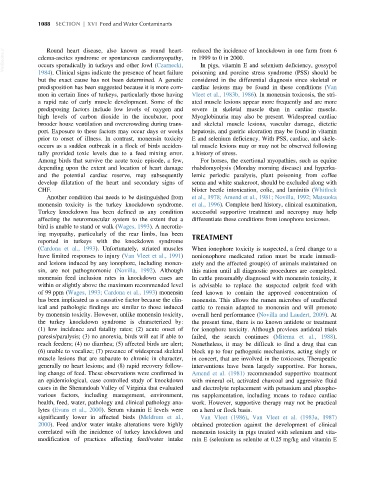Page 1156 - Veterinary Toxicology, Basic and Clinical Principles, 3rd Edition
P. 1156
1088 SECTION | XVI Feed and Water Contaminants
VetBooks.ir edema-ascites syndrome or spontaneous cardiomyopathy, reduced the incidence of knockdown in one farm from 6
Round heart disease, also known as round heart-
in 1999 to 0 in 2000.
occurs sporadically in turkeys and other fowl (Czarnecki,
In pigs, vitamin E and selenium deficiency, gossypol
1984). Clinical signs indicate the presence of heart failure poisoning and porcine stress syndrome (PSS) should be
but the exact cause has not been determined. A genetic considered in the differential diagnosis since skeletal or
predisposition has been suggested because it is more com- cardiac lesions may be found in these conditions (Van
mon in certain lines of turkeys, particularly those having Vleet et al., 1983b, 1986). In monensin toxicosis, the stri-
a rapid rate of early muscle development. Some of the ated muscle lesions appear more frequently and are more
predisposing factors include low levels of oxygen and severe in skeletal muscle than in cardiac muscle.
high levels of carbon dioxide in the incubator, poor Myoglobinuria may also be present. Widespread cardiac
brooder house ventilation and overcrowding during trans- and skeletal muscle lesions, vascular damage, dietetic
port. Exposure to these factors may occur days or weeks hepatosis, and gastric ulceration may be found in vitamin
prior to onset of illness. In contrast, monensin toxicity E and selenium deficiency. With PSS, cardiac, and skele-
occurs as a sudden outbreak in a flock of birds acciden- tal muscle lesions may or may not be observed following
tally provided toxic levels due to a feed mixing error. a history of stress.
Among birds that survive the acute toxic episode, a few, For horses, the exertional myopathies, such as equine
depending upon the extent and location of heart damage rhabdomyolysis (Monday morning disease) and hyperka-
and the potential cardiac reserve, may subsequently lemic periodic paralysis, plant poisoning from coffee
develop dilatation of the heart and secondary signs of senna and white snakeroot, should be excluded along with
CHF. blister beetle intoxication, colic, and laminitis (Whitlock
Another condition that needs to be distinguished from et al., 1978; Amend et al., 1981; Novilla, 1992; Matsuoka
monensin toxicity is the turkey knockdown syndrome. et al., 1996). Complete herd history, clinical examination,
Turkey knockdown has been defined as any condition successful supportive treatment and necropsy may help
affecting the neuromuscular system to the extent that a differentiate these conditions from ionophore toxicoses.
bird is unable to stand or walk (Wages, 1993). A necrotiz-
ing myopathy, particularly of the rear limbs, has been TREATMENT
reported in turkeys with the knockdown syndrome
(Cardona et al., 1993). Unfortunately, striated muscles When ionophore toxicity is suspected, a feed change to a
have limited responses to injury (Van Vleet et al., 1991) nonionophore medicated ration must be made immedi-
and lesions induced by any ionophore, including monen- ately and the affected group(s) of animals maintained on
sin, are not pathognomonic (Novilla, 1992). Although this ration until all diagnostic procedures are completed.
monensin feed inclusion rates in knockdown cases are In cattle presumably diagnosed with monensin toxicity, it
within or slightly above the maximum recommended level is advisable to replace the suspected culprit feed with
of 99 ppm (Wages, 1993; Cardona et al., 1993) monensin feed known to contain the approved concentration of
has been implicated as a causative factor because the clin- monensin. This allows the rumen microbes of unaffected
ical and pathologic findings are similar to those induced cattle to remain adapted to monensin and will promote
by monensin toxicity. However, unlike monensin toxicity, overall herd performance (Novilla and Laudert, 2009). At
the turkey knockdown syndrome is characterized by: the present time, there is no known antidote or treatment
(1) low incidence and fatality rates; (2) acute onset of for ionophore toxicity. Although previous antidotal trials
paresis/paralysis; (3) no anorexia, birds will eat if able to failed, the search continues (Mitema et al., 1988).
reach feeders; (4) no diarrhea; (5) affected birds are alert; Nonetheless, it may be difficult to find a drug that can
(6) unable to vocalize; (7) presence of widespread skeletal block up to four pathogenic mechanisms, acting singly or
muscle lesions that are subacute to chronic in character, in concert, that are involved in the toxicoses. Therapeutic
generally no heart lesions; and (8) rapid recovery follow- interventions have been largely supportive. For horses,
ing change of feed. These observations were confirmed in Amend et al. (1981) recommended supportive treatment
an epidemiological, case controlled study of knockdown with mineral oil, activated charcoal and aggressive fluid
cases in the Shenandoah Valley of Virginia that evaluated and electrolyte replacement with potassium and phospho-
various factors, including management, environment, rus supplementation, including means to reduce cardiac
health, feed, water, pathology and clinical pathology ana- work. However, supportive therapy may not be practical
lytes (Evans et al., 2000). Serum vitamin E levels were on a herd or flock basis.
significantly lower in affected birds (Meldrum et al., Van Vleet (1986), Van Vleet et al. (1983a, 1987)
2000). Feed and/or water intake alterations were highly obtained protection against the development of clinical
correlated with the incidence of turkey knockdown and monensin toxicity in pigs treated with selenium and vita-
modification of practices affecting feed/water intake min E (selenium as selenite at 0.25 mg/kg and vitamin E

